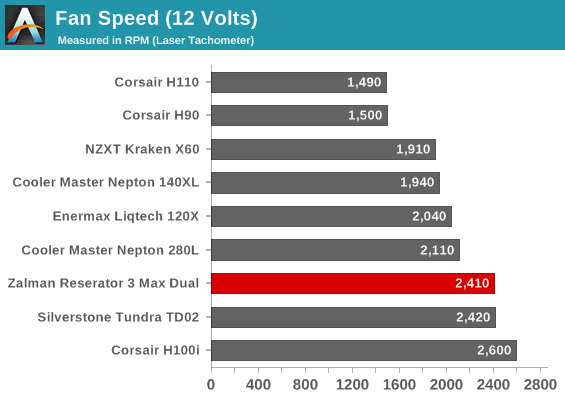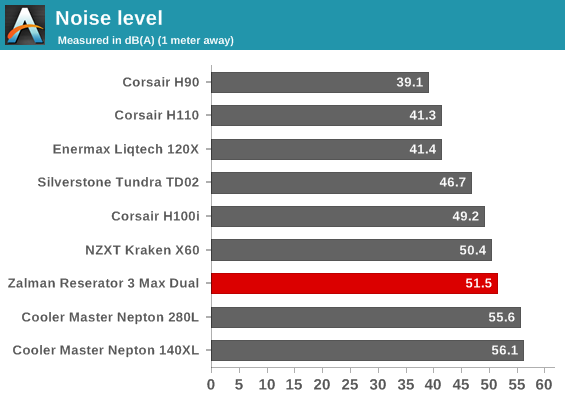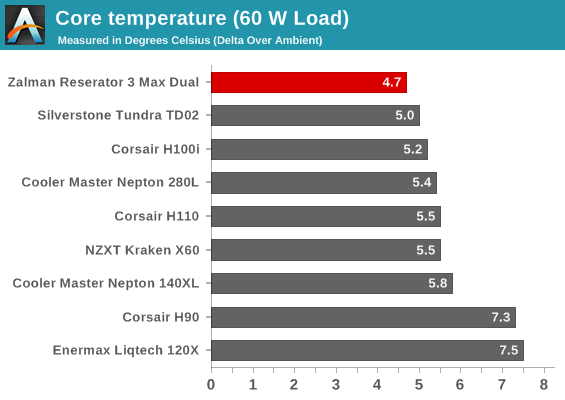Zalman Reserator 3 Max Dual CPU Cooler Review
by E. Fylladitakis on August 19, 2014 6:00 PM ESTTesting Results, Maximum Fan Speed (12 Volts)
The first round of testing takes place with the supply voltage of the fans and pumps at 12V. This should depict the maximum possible performance of each cooler without any modifications.



| Core Temperature, Constant Thermal Load |
|
|

From the above charts, we can see that the Reserator 3 Max Dual has different behavior than many of the other coolers. Zalman's cooler behaves extremely well when the load is low, easily claiming the top spot of our thermal performance charts and outperforming even the larger 280 mm radiator designs. However, the performance of the Reserator 3 Max Dual decreases as the load increases and it can't really keep up with the competition at very high loads. The end result is a middling, unsurprising average thermal resistance. The sound pressure of Zalman's 120 mm LED fans at maximum speed is an ear-bursting 51.5 dB(A) as well, though that's no surprise considering the specifications.










52 Comments
View All Comments
lorribot - Tuesday, August 19, 2014 - link
You go in to great detail about your test rig and how you test thermal efficiency but completely fail on how you actually test noise, just some " noise measurements are a bit tricky" statement .Actually it is not.
A good test would be the amount of noise produced to cool a given thermal load to say 70C. This would replicate what I would want in the real world, ie how much noise will this thing make cooling my i5/i7 when playing a game or doing massive calculations etc.
Most noise tests seem arbitrary, such as dB with fans a full speed which is worthless information and provides no useful comparison as all fans run a different speed or are subjective observations of the quality of the noise.
Noise generated for a number of given workloads would actually be useful please make it happen.
Hairs_ - Tuesday, August 19, 2014 - link
Silent pc review provide this sort of analysis, in an anaechoic chamber, with stock vs. reference fans. However, their db classification for "silent" is different, and liquid coolers always perform worse than a good air cooler on a "cooling per dB" metric.SPCR's conclusion (which I'd trust above all others) is that liquid coolers are a bad investment as they cost significantly more, produce worse results and are often far too noisy to justify the results. Push enough air and create enough noise, and you can get all sorts of headline grabbing low temperature results...
Gigaplex - Tuesday, August 19, 2014 - link
While I agree that air cooling is generally preferable to liquid cooling from an audible efficiency perspective, at the extreme overclocking end of the scale, air coolers just can't keep up. Another downside to the massive tower air coolers is that there's greater risk of damaging the system during frequent transportation (eg LAN party users). There are trade-offs either way you go.That said, I prefer air cooling as I optimise my systems for noise.
AnnihilatorX - Thursday, August 21, 2014 - link
I disagree. At normal fan speeds liquid coolers tend to lower temperature range and variance, you won't see ultra low temperature, nor you won't see ultra high temperature, and this is due to specific heat capacity of the liquid being higher than air. While overclocked working CPU on air coolers can reach say 70+ deg C, on liquid it would barely reach 40 deg C (speaking from experience) . This is what is important, not low idle temperature.AnnihilatorX - Thursday, August 21, 2014 - link
To clarify the above reply was replying to Hair not GigaplexE.Fyll - Wednesday, August 20, 2014 - link
Actually, it is not as simple as that. Noise measurements are indeed very tricky.Your proposed method however is indeed interesting. However, I would need specific equipment to emulate the PWM thermal control of a motherboard and control the coolers in order to maintain a set temperature. I will be adding that in my long "to buy" list.
I just hope that this will not then start a "comments war" on topics such as "why 150W load and not 160W load", etc etc. :)
Impulses - Tuesday, August 19, 2014 - link
Dunno why we're still obsessed with CPU cooling when must enthusiasts are running GPUs that get far hotter and many are running several of them.We really need some sorta standard bracket/mount that could facilitate mounting these things to GPUs... Anand has featured a couple but they all seemed to have issues, or maybe I didn't pay close enough attention.
SantaAna12 - Tuesday, August 19, 2014 - link
Agree in general about GPUS......but....this is a CPU cooler review that anticipates a new line of enthusiast unlocked chips. Right on time perhaps?abhaxus - Tuesday, August 19, 2014 - link
I have the Kraken G10 mounting a Kuhler 620 to my reference R9 290. I replaced the Kuhler's fan with the stock fan from an H100 and the radiator is mounted in a rigged up location in my case (have it mounted in the 5.25" bays of my Bitfenix Raider). With the fan on low, it is silent and will only hit 90C if I play an extended session of a high GPU usage game (Crysis 3, BF4). With the fan on medium, which is inaudible with music/game audio playing, I never hit over 70C. This is with the card overclocked to 1107/1350 @ +100mv in Afterburner. My VRM temps stay at around 59-65C as well, and I did NOT put VRM sinks on there, just the standard 92mm fan that comes with the G10.Very good purchase overall. Now that the Swiftech H220 is back in America I think I will be purchasing one to properly loop my GPU, however.
flyingpants1 - Wednesday, August 20, 2014 - link
I'm totally in agreement, except for the part where you say "many are running several of them". The market for exotic coolers is pretty tiny, and the amount of people who run multiple GPU setups is vanishingly small.I'd guess over 90% of PC gamers are using single GPUs under 200 watts, GTX 760 or R9 270x. I'd like to see a slew of water coolers released for those cards.
The PC market is really, really, reeeeally slow to adapt. It took like 20 years to make USB cables reversible. They're still using ATX, for god's sake. Mini-ITX is nice, but Apple's new Mac Pro slaughters everything from a design standpoint.